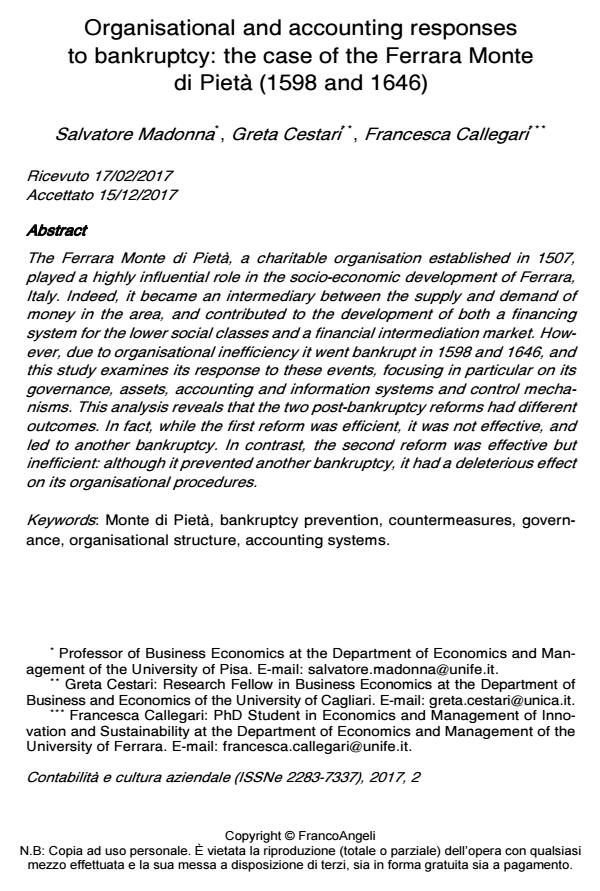Organisational and accounting responses to bankruptcy: the case of the Ferrara Monte di Pietà (1598 and 1646)
Journal title CONTABILITÀ E CULTURA AZIENDALE
Author/s Salvatore Madonna, Greta Cestari, Francesca Callegari
Publishing Year 2017 Issue 2017/2
Language English Pages 32 P. 71-102 File size 257 KB
DOI 10.3280/CCA2017-002004
DOI is like a bar code for intellectual property: to have more infomation
click here
Below, you can see the article first page
If you want to buy this article in PDF format, you can do it, following the instructions to buy download credits

FrancoAngeli is member of Publishers International Linking Association, Inc (PILA), a not-for-profit association which run the CrossRef service enabling links to and from online scholarly content.
The Ferrara Monte di Pietà, a charitable organisation established in 1507, played a highly influential role in the socio-economic development of Ferrara, Italy. Indeed, it became an intermediary between the supply and demand of money in the area, and contributed to the development of both a financing system for the lower social classes and a financial intermediation market. However, due to organisational inefficiency it went bankrupt in 1598 and 1646, and this study examines its response to these events, focusing in particular on its governance, assets, accounting and information systems and control mechanisms. This analysis reveals that the two post-bankruptcy reforms had different outcomes. In fact, while the first reform was efficient, it was not effective, and led to another bankruptcy. In contrast, the second reform was effective but inefficient: although it prevented another bankruptcy, it had a deleterious effect on its organisational procedures.
Keywords: Monte di Pietà, bankruptcy prevention, countermeasures, governance, organisational structure, accounting systems.
- Banks and financial institutions in historical perspective Valerio Antonelli, Nieves Carrera, Christopher Napier, in CONTABILITÀ E CULTURA AZIENDALE 1/2018 pp.9
DOI: 10.3280/CCA2018-001002 - Special Issue: Accounting in different cultures and from different perspectives. Banking function and accounting practices from 1810 to 1897: The case of the Monte di Pietà in Milan Andrea Amaduzzi, Paola Orlandini, Mariarita Pierotti, in CONTABILITÀ E CULTURA AZIENDALE 2/2019 pp.13
DOI: 10.3280/CCA2018-002003 - A historical comparison exactly one hundred years apart. The global financial crises of 1907 and 2007 and the FIAT case study Stefano Garzella, Rosita Capurro, Stefano Marciano, in CONTABILITÀ E CULTURA AZIENDALE 1/2024 pp.43
DOI: 10.3280/CCA2024-001003
Salvatore Madonna, Greta Cestari, Francesca Callegari, Organisational and accounting responses to bankruptcy: the case of the Ferrara Monte di Pietà (1598 and 1646) in "CONTABILITÀ E CULTURA AZIENDALE" 2/2017, pp 71-102, DOI: 10.3280/CCA2017-002004